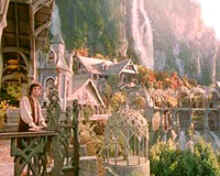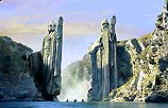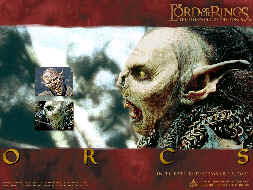
VISUAL EFFECTS
However this film's visual aspect relies not only on New Zealand's beauty and Peter Jackson's camera moves, but also upon the amazing digital and visual effects that are integrated seamlessly throughout the movie. The Weta Digital visual effects team that brought to life such creatures as Gollum and Treebeard, has created the benchmark by which all visual effects will likely be judged from here on.
Their ability to make a digital thing like Gollum who exists in a computer resonate emotion and feeling is a work of true genius. The visual effects shine not only in the obvious areas such as Gollum, but in the subtle effects that can barely be noticed; shadows formed by digital creatures that aren't there, lighting effects that create a mood in the scene that is otherwise non-existent. All of these things have been worked together so will with the real-time footage and acting, that you end up never knowing what is real and what is digital. It's a merit of the visual-effects supervisor for The Lord of the Rings, Jim Rygiel.
The digital effects are, for instance, Gollum, CG-related. The compositing is all digital effects. As a visual-effects supervisor, Jim's role was to marry the live-action footage that director shoots along with miniatures, combine that all, and figure out if it's best to do it digitally or with a miniature.

Gollum is amazing. He changed a little bit. In movie one they had a little taste of him in there. Peter was pushing the technology. But Gollum in particular, he said, "Let's stick Gollum in film one," and of course they weren't ready. So they had to scramble to get it all together. With film two they started with the same Gollum and worked down the path They realized since it was a cartoony-looking character, it was difficult to make him act like a person, which was important. Andy Serkis was Gollum, who was phenomenal. Just look at him with the latex or Lycra suit he had on. He was fantastic. So they modeled their Gollum after the facial features of Andy Serkis. They got the digital on top of him. One of the ways to do it is straight key frame animation. They had many animators working. They wanted more realism, so they did motion-capture. They put markers on a person and captured their motions. Another way is a process called "rotomation." Andy was shot on the set with the actors. They then took their digital Gollum and frame-for-frame copy Andy's motions as he's moving.
The crew constantly invented a lot of new techniques. And technology was just advancing along the way. One of the advancements was on-set motion capture of Andy Serkis. They had motion-capture cameras on the set as Peter directed the actors. Kind of a second unit that's shooting at the same time. It's a second unit in parallel. So you don't have to go back to the motion-capture stage.

In film there wasn't any robotics. In case with Shelob the spider-like creature they covered up part of that motion with digital. They tried to make a puppet. They started out with 1950s spider hands coming in and clawing at the guy and quickly realized it wasn't going to work. So Shelob was completely digital, completely hand-animated, all key framed, keeping the proper perspective.
It's surprising to see Frodo, Elijah Wood, who's a normal-size actor standing next to Gandalf, Ian McKellan, who's a normal-size actor. You wonder how did they make the size difference realistic. Peter was very savvy at in-camera effects. This is an old and new technology. They did some hobbit scales, where they shot them against a blue screen. Then they'd shrink them down later. But Peter was very savvy with camera angles, knowing that if Jim has dug a hole and lower the guy down, he would have looked smaller, and when they were reversed, for Gandalf, they had a guy called "Tall Paul," 7 foot 5, and he'd be Gandalf from the back. It was just playing a lot of tricks.
All they needed to do was to have those one or two shots, where they had a wide shot of them standing and talking, and the camera moving around that sells their size. And for the rest of the movie you forget about it. AI and giant elephants
The riders on the elephants are all digital. Besides the riders, there's that whole basket on top. Leather straps. They had to react to the mumakils' actions. The riders, which were massive, this artificial intelligence thing that did the armies, they would react to the basket too. So it was this multilayer cake they had to put together. The armies were interesting. Normally, when we see a battle scene like this, there are five different things they can do. Then you repeat it randomly. But the armies in LOTR were kind of autonomous. They started with live-action guys that they motion-captured. They had hundreds of different cycles. So they'd have runs, slashing, walks, dying. The cool thing about MASA (-the AI engine, the artificial intelligence engine) is that it gives each of these 200,000 guys a brain and says, "Head toward that wall and attack anything that's gold." The gold armor. So each player would have a mission. They gave them what is called "call sheets." The call sheet would say "run to the wall," obviously in a digital format. Or "You're going to attack anything wearing gold armor." They also had auditory senses and could turn around and hack back at attackers. It's known that during shooting a strange story happened: those guys were actually running away, as if they were actually scared. They weren't behaving like it was supposed.
When Jim was showed this tape, this rustic form with guys fighting, he saw in the background these guys in the distance running away and said, "Those are the smart ones. They're running away." They're not actually running away. They're running around the world to get around to the other side. They're programmed to attack. They're just looking the wrong way. Evolution of digital effects.
In our opinion the most breathtaking scenes in the movie are the moments of patient observation, when the camera pans around and captures the beautiful settings of Middle Earth. There are particular moments that stick out in mind and gave that tingle of goosebumps down the spine when you saw them for the first time.
The first is the introduction to Hobbiton. Hobbiton was perfect. The houses have flower patches and old fences, the roads look worn and made through decades of travel, and the Old Mill spins with the laziness of a quiet town. Every color is vibrant and every moment looks as through it was taken out of a picture book.

The second moment comes after Frodo's awakening in Rivendell, and the third, during the exploration of the Halls of Moria. In both moments, the camera pans away from the characters and outward into a static shot of their surroundings. The moments make us feel like we're turning our heads and gazing at the world around us just as the characters do. The golden waterfalls of the elven city mark an interesting contrast with the dark halls of the dwarfish mines, but each are inspiring in their own ways and add to feeling of being engaged in a living world. Our other favorite moment is the exploration of Lothlorien and the passage down the Anduin.
The one stellar thing about LOTR is that through all the technical wizardry, the films never lose their basic humanity. It is really the story of love and friendship, evil and greed, the lust for power and the love of freedom that make these three films the great accomplishments they truly are.